In this guide, we will explore a selection of notable evergreen tropical plants, highlighting their unique characteristics, care requirements, and the beauty they can bring to your garden.
Bamboo
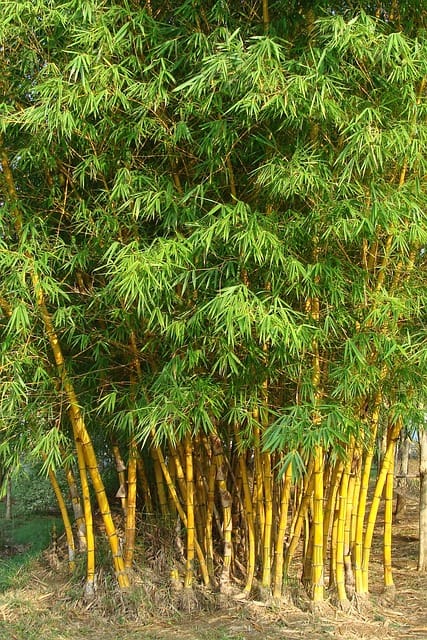
Bamboo is not just a plant; it’s an iconic symbol of strength and flexibility found in many tropical regions worldwide. With its tall, hollow stems and rapid growth rate, bamboo can create a striking backdrop in any garden. Bamboo not only thrive in warm climates but also provide a natural privacy screen when planted in clusters. They can grow remarkably quickly, with some species reaching maturity in a matter of months. In addition to being visually stunning, bamboo’s versatility extends to uses in construction, furniture-making, and even culinary practices. Planting bamboo requires careful selection of species, as some can be invasive, so maintenance and proper containment are key to managing its growth.
Colocasia

Colocasia, often referred to as elephant ears due to their large, heart-shaped leaves, are tropical perennials that add a dramatic flair to any garden. These plants thrive in moist, fertile soil and require filtered sunlight to flourish. Their foliage can vary from deep green to striking variegated patterns, creating a verdant canvas that draws the eye. Aside from their ornamental use, colocasia is also grown for its starchy tubers, which are consumed in various cuisines around the globe. When cultivating colocasia, ensure adequate water supply, as they prefer a consistently moist environment, making them ideal near ponds or in rain gardens.
Hibiscus

Hibiscus is synonymous with tropical aesthetics, revered for its large, showy blossoms that bloom in a stunning array of colors. These flowering plants are not only visually captivating but also attract various pollinators, including bees and hummingbirds. With numerous species and hybrids available, hibiscus can be cultivated as shrubs or small trees, offering versatility in landscaping. Regular pruning encourages bushier growth and more abundant flowers. Hibiscus prefers full sun and well-drained soil, making it a fantastic choice for bright, warm locations in your garden. The delightful fragrance of the blooms and the rich green foliage make this plant a staple in tropical landscaping.
Bird of Paradise

Named for its striking, bird-like flowers, the Bird of Paradise (Strelitzia reginae) is a spectacular tropical perennial that can create a focal point in any garden. With leaves resembling those of a banana plant, its iconic flowers emerge in vibrant orange and blue-yellow hues, reminiscent of a tropical bird in flight. This plant thrives in well-drained soil and full sun conditions, which encourages flowering. While relatively hardy, Bird of Paradise requires careful watering practices to prevent root rot. Its dramatic presence and unique floral design make it a favorite among landscapers and garden enthusiasts alike, often seen in both residential and commercial settings.
Palms

When one thinks of the tropics, palms often come to mind, symbolizing warmth and paradise. These iconic plants come in various species, such as the majestic Royal Palm and the slender Areca Palm. Known for their fan-shaped or feather-like leaves, palms add a touch of elegance and relaxation to any landscape. They serve as excellent focal points or can be used in clusters to enhance visual impact. Palms thrive in full sunlight and well-draining soil, making them generally low-maintenance options for those looking to achieve a tropical feel without excessive effort. Their longevity and resilience further establish palms as quintessential elements in tropical gardening.
Indian Shot

The Indian Shot, also known as Canna indica, boasts stunning, large, tropical leaves and eye-catching flowers that bloom in bright reds, oranges, and yellows. This plant is particularly valued for its ability to tolerate wet soil, making it ideal for water gardens and areas that experience heavy rainfall. Indian Shot grows tall, with some varieties reaching up to six feet, creating a bold statement in your garden landscape. Beyond their ornamental value, the seeds of the Indian Shot have historical significance as they were once used for making jewelry and buttons. With proper care, including regular fertilization and adequate watering, Indian Shot can be a vibrant addition to your collection of evergreen tropicals.
Banana

The banana plant represents the quintessential tropics, with its immense leaves that create a dramatic canopy overhead. While often mistaken for trees, bananas are technically large herbaceous plants. They thrive in warm, humid conditions and can grow swiftly, producing clusters of bananas in the process. Known for their ability to make a bold statement in any garden, banana plants not only provide visual interest but also yield delicious fruit that can be harvested and enjoyed. They prefer bright sunlight and rich, well-draining soil to support their rapid growth. In addition to their aesthetic and culinary appeal, the large leaves can be used as natural umbrellas to provide shade or as artistic decorations in outdoor settings.
Ferns

Ferns are among the most ancient plants on Earth and offer an exquisite softness to any tropical garden. With their feathery fronds and diverse species, ferns create a lush, layered effect that appeals to gardeners seeking to foster a naturalistic look. Many ferns thrive in the shaded understory of tropical forests, making them perfect for integrating into gardens where sunlight can be a limiting factor. They are generally low-maintenance yet require moist, well-draining soil to flourish. Notably, ferns contribute to biodiversity, providing habitats for small creatures and insects. Popular ferns for tropical gardens include Boston Ferns and Bird’s Nest Ferns, which add elegance and texture to the landscape. Given their historical association with mystery and exoticism, ferns evoke a sense of tropical adventure within your garden.
African Lily

The African Lily, or Agapanthus, is an enchanting flowering plant that thrives in tropical regions. Known for its stunning globe-like clusters of blue or white flowers atop tall stems, this perennial brings a sense of both elegance and vigor to the garden. African Lilies are remarkably adaptable, thriving in both sunny and partially shaded locations, making them versatile choices for a variety of garden settings. They produce lush, strap-like leaves that add texture to your landscaping even when not in bloom. Proper drainage is essential for their maintenance, as standing water can lead to root rot. The blooms typically attract butterflies and other pollinators, contributing to the biodiversity of your garden. With their enduring beauty and ability to thrive in tropical conditions, African Lilies are a must-have for creating vibrant floral displays.
Bougainvillea

Bougainvillea is a spiny shrub known for its breathtaking drapes of colorful bracts, creating spectacular visual displays. This plant thrives in full sun and can flourish in various types of soil, although it prefers well-drained environments. Bougainvillea’s striking colors range from bright pinks and purples to oranges and whites, making it a popular choice for gardens, trellises, and as ground cover. The plant is drought-tolerant once established, making it an excellent choice for low-maintenance gardens. Its prolific blooms attract pollinators, adding to its charm. With the right pruning techniques, bougainvillea can be shaped into beautiful topiaries or allowed to cascade freely, creating a striking focal point in any tropical landscape.
Yucca

Yucca plants bring a dramatic touch to tropical gardens with their sword-like leaves and striking architectural form. These succulents are known for their resilience and adaptability to various conditions, thriving in well-drained, sandy soils with full sun exposure. While yuccas are often associated with arid climates, several species can thrive in tropical settings, making them versatile additions to your landscape. They produce tall flower spikes adorned with white or cream-colored blossoms that bloom during the summer, attracting pollinators like bees and butterflies. Yuccas are not just visually arresting; they can also serve practical purposes, being used for fiber to create products such as ropes and textiles. Given their low-maintenance needs and extraordinary visual appeal, yuccas are a brilliant choice for gardeners seeking a bold, yet resilient, tropical flair.
Mandevilla

Mandevilla is a spectacular vine known for its striking, trumpet-shaped flowers that bloom in shades of pink, red, yellow, and white. This tropical plant thrives in warm climates, making it a favorite for gardeners looking to add a pop of color to trellises, fences, or arbors. With its lush, glossy leaves and rapid growth rate, mandevilla can quickly cover vertical spaces and create a dramatic visual impact. It prefers full sun and well-drained soil, and while it’s relatively drought-tolerant, regular watering encourages more vigorous blooming. Mandevilla also attracts pollinators, such as hummingbirds and butterflies, adding to the vibrancy of your garden. Given its vigorous growth habit, regular pruning is advisable to maintain shape and encourage denser foliage and blooms. This perennial delight is perfect for adding a tropical touch to patios and outdoor spaces.
Japanese Silver Grass

Japanese Silver Grass (Miscanthus sinensis) is a graceful ornamental grass that brings texture and movement to the tropical garden. Known for its feathery plumes and arching leaves, this grass can grow quite tall, providing a soft backdrop or a striking focal point. The plant thrives in full sun to partial shade and is drought-tolerant once established, making it a low-maintenance choice for gardeners. Japanese Silver Grass is particularly stunning in the autumn when its foliage turns golden and the flower plumes catch the sunlight, creating a shimmering effect. This plant also offers wildlife benefits, as its dense growth provides nesting sites for birds. With its versatility and year-round interest, Japanese Silver Grass is a fantastic addition to any tropical landscaping.
Umbrella Plant
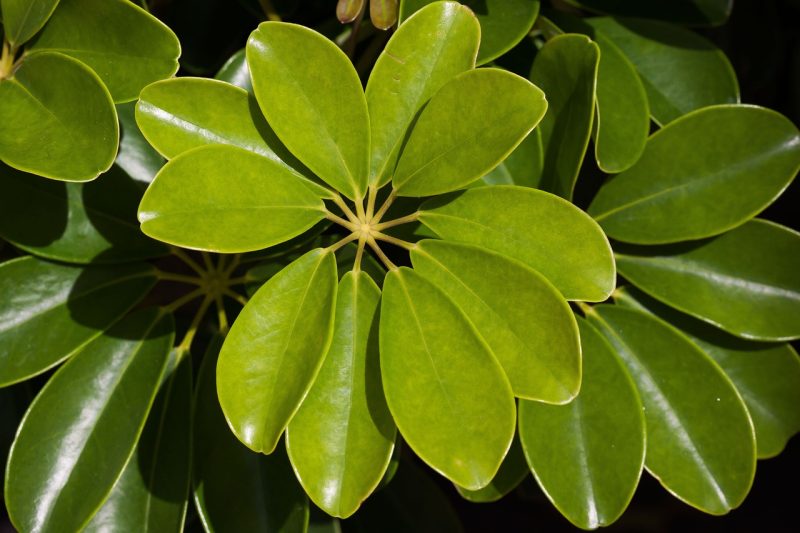
The Umbrella Plant, or Schefflera, is celebrated for its unique leaf structure, featuring glossy, hand-shaped leaves that emerge in clusters resembling an umbrella. This evergreen perennial thrives in tropical climates and makes an excellent choice for both outdoor and indoor gardening. Umbrella plants prefer bright, indirect light with some shade, making them perfect for patios or areas with filtered sunlight. Providing consistent moisture while avoiding waterlogging is crucial for their health. These plants can grow into small trees, adding vertical interest to your garden. Additionally, the Umbrella Plant is noted for its air-purifying qualities, making it a health-conscious and beautiful option for your living spaces.
Pineapple Lily
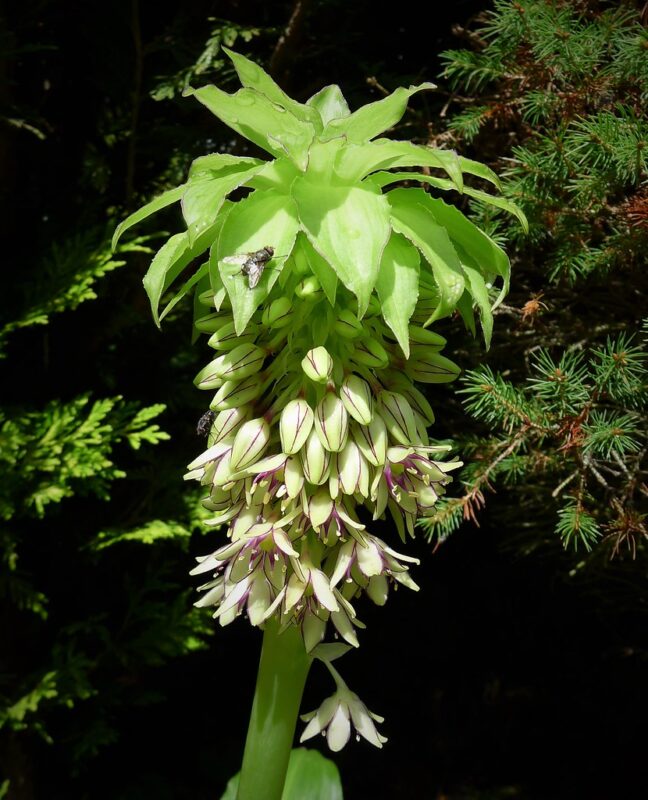
Pineapple Lily (Eucomis spp.) is a unique and eye-catching plant originating from South Africa. Resembling a pineapple due to its rosette form of leaves and tall flower spikes, Pineapple Lilies produce green or white flowers that slowly transform to shades of pink and purple throughout the blooming season. They thrive in full sun and enjoy well-draining soil, making them suitable for tropical gardens. Aside from their ornamental value, Pineapple Lilies attract various pollinators like bees and butterflies, contributing to the ecological balance of the garden. With their intriguing structure and low maintenance requirements, Pineapple Lilies serve as excellent specimens for container gardening or mixed borders.
Passionflower

Passionflower (Passiflora) delivers both exotic beauty and culinary delight, as its striking flowers attract admirers and produce edible fruit known as passionfruit. With their intricate floral designs, consisting of unique star shapes surrounded by filaments, these tropical vines can add a whimsical touch to your garden. Passionflowers prefer full sun and well-drained soil and can thrive in containers or as ground cover. This vigorous climber can quickly cover trellises and fences, creating a lush environment that is ideal for attracting pollinators. The fruits are not only delicious but also rich in nutrients, making this plant an attractive choice for both aesthetics and the table. Passionflowers do require regular pruning to control their growth, but their rewards in blooms and fruit make them worth the effort.
Cordyline

Cordyline, commonly known as ti plant, adds a tropical flair to any garden with its long, strap-like leaves that can exhibit vibrant colors, ranging from deep greens to striking reds and purples. This plant thrives in warm, moist environments, making it well-suited for tropical landscapes. Cordyline can be grown as a striking centerpiece in garden beds or as a potted plant on patios. They do well in partial shade but can tolerate full sun if properly watered. As they grow, mix different varieties to create a vibrant and eye-catching display, contrasting the various foliage colors and shapes. Cordyline’s ability to adapt to various soil types makes it an excellent choice for a colorful garden featuring easy-care plants.
Dinosaur Food
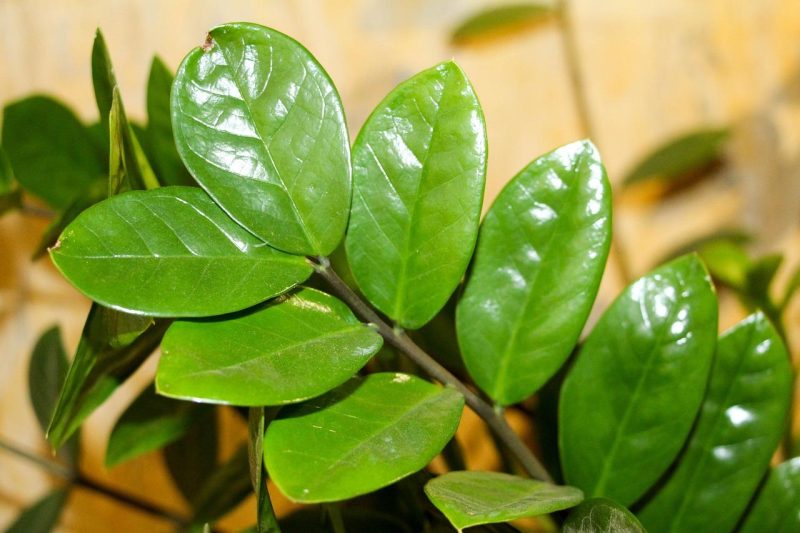
Dinosaur food, or zamioculcas zamiifolia, is a resilient and adaptable plant often referred to as ZZ plant. With its glossy, thick leaves that emerge from a central stalk, it thrives in low-light conditions, making it perfect for tropical gardens lacking full sunlight. This plant is incredibly drought-tolerant, capable of storing water in its rhizomes, making it virtually care-free. Dinosaur food has become popular not only for its visual appeal but also for its air-purifying qualities, which help improve indoor air quality. This hardy plant can be a lush addition to your garden, and it often flourishes in pots or as an indoor specimen in bright, indirect light. With minimal maintenance requirements and striking green leaves, Dinosaur Food is a fantastic choice for gardeners looking to add a touch of greenery without the need for constant attention.
Soft Tree Fern

Soft Tree Fern (Dicksonia antarctica) offers a distinctive tropical look that harks back to prehistoric times, with its tall, woody trunk and large, feathery fronds. This evocative plant can reach heights of up to 10 feet, creating a dramatic presence in any garden. Soft Tree Ferns thrive in shaded or partially shaded areas with consistently moist, rich soil, making them perfect for understory planting and creating a tropical ambiance. They require protection from harsh winds and full sun exposure, which can scorch their delicate leaves. Incorporating these ferns into your landscape not only adds vertical elements but also contributes to biodiversity, providing a habitat for various insects and small creatures. Their ancient appeal and graceful form make them a unique addition to any collection of evergreen tropical plants.
Eucalyptus

Eucalyptus trees are revered for their aromatic foliage and stunning, mottled bark, which can range in color from grey to brown. While some species can grow quite large, others remain compact, making them versatile for both large gardens and smaller spaces. Eucalyptus thrives in full sun and well-draining, sandy loam soil, and it is remarkably drought-tolerant once established. These trees also produce vibrant flowers that attract pollinators, adding to the ecological benefit of a garden. Additionally, eucalyptus leaves have medicinal properties, and their essential oils are used in aromatherapy and natural wellness products. With their unique fragrance and majestic presence, eucalyptus trees can create a serene and relaxing atmosphere in any tropical setting.
Curve Leaf Yucca
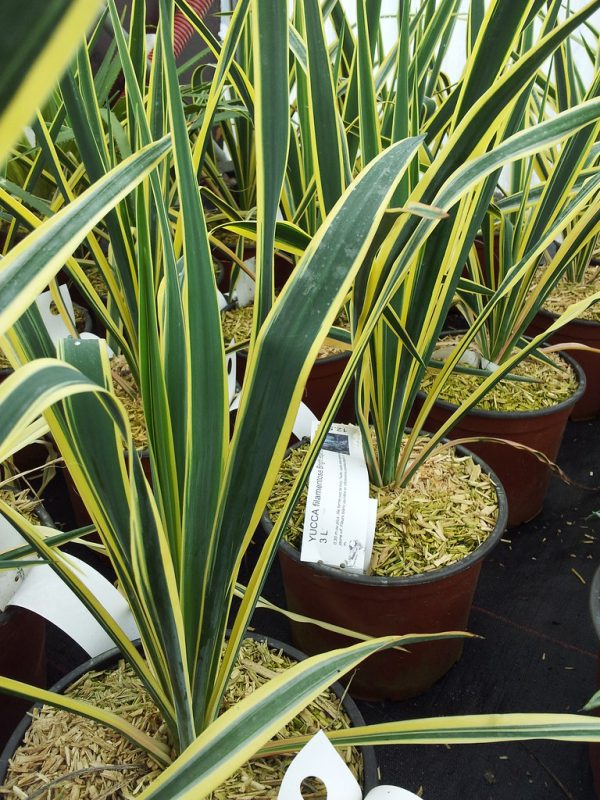
Curve Leaf Yucca (Yucca filamentosa) is an attractive shrub characterized by its arching, sword-like leaves that curve gracefully, adding elegant structure to gardens. This hardy plant is suitable for tropical environments and is well-adapted to a range of soil types, preferring well-draining conditions. Curve Leaf Yucca thrives in full sun and is drought-tolerant, making it a low-maintenance choice for busy gardeners. The striking leaves can produce tall spikes adorned with creamy white flowers in the summer, creating eye-catching vertical interest. Its resilient nature makes it a popular choice for xeriscaping or regions with low water availability, while its sculptural form complements various landscaping styles. Curve Leaf Yucca is an excellent choice for those seeking a unique and hardy tropical plant that provides visual appeal year-round.
Rice Paper Plant

The Rice Paper Plant (Tetrapanax papyrifer) is a fascinating tropical shrub originally cultivated in Asia, known for its enormous, palmate leaves that can grow up to three feet across. The leaves have a striking resemblance to those of giant taro and provide a lush backdrop in any tropical landscape. This plant thrives in well-drained, moist soil and prefers partial shade to full sun. Its rapid growth can create an impressive canopy in the garden, offering shade and shelter to smaller plants and wildlife. Additionally, the inner pith of its stems is used in the production of traditional rice paper. The Rice Paper Plant is ideal for creating a tropical oasis, as its large leaves can provide dramatic contrast against smaller blooming plants while enhancing the overall lushness of the environment.
Coral Bells

Coral Bells (Heuchera) are perennial plants celebrated for their dazzling foliage that can feature an array of colors, including deep purples, bright greens, and silvery variegations. Although native to North America, these plants thrive in tropical gardens as well, adapting to a variety of soil types, as long as they have good drainage. Coral Bells are typically grown for their foliage, with delicate flower spikes emerging in late spring to early summer, attracting pollinators such as butterflies. They prefer partial shade but can tolerate full sun conditions in cooler climates. Their unique leaf shapes and colors offer year-round interest, making them excellent choices for mixed borders or containers. Additionally, Coral Bells can thrive in more challenging garden environments and are relatively low-maintenance, inviting gardeners to enjoy their beauty without excessive effort.
Caladium

Caladiums are undoubtedly some of the most colorful tropical plants you can incorporate into your garden. Known for their heart-shaped leaves, which come in vibrant patterns of green, white, pink, red, and even purple, caladiums are a must-have for adding dramatic color to shaded areas. These tuberous perennials thrive in rich, organic soil that retains some moisture but drains adequately. They prefer filtered sunlight to partial shade, making them ideal for garden beds beneath taller plants or trees. Caladiums are excellent in pots and can be used for borders to add vivid contrast to the plant palette. Often called “Angel Wings,” their stunning foliage can create lush and vibrant visual interest, transforming any gardening area into a tropical paradise.
Japanese Aralia

Japanese Aralia (Fatsia japonica) is an outstanding evergreen shrub known for its large, glossy, palmate leaves that can reach up to 12 inches wide. This tropical plant thrives in shaded to partially shaded areas, making it perfect for creating lush, green underplantings or filling in shady corners of the garden. Japanese Aralia is relatively low-maintenance, preferring rich, well-draining soil with consistent moisture. Its dramatic foliage provides an excellent backdrop for other colorful plants, and it can also be used as a specimen plant due to its striking appearance. In autumn, Japanese Aralia produces small white flowers that can attract pollinators, adding to the biodiversity of your garden. This plant not only enhances the aesthetic appeal of your landscape with its bold leaves but also serves a functional purpose by helping to create biodiversity within your tropical environment.





